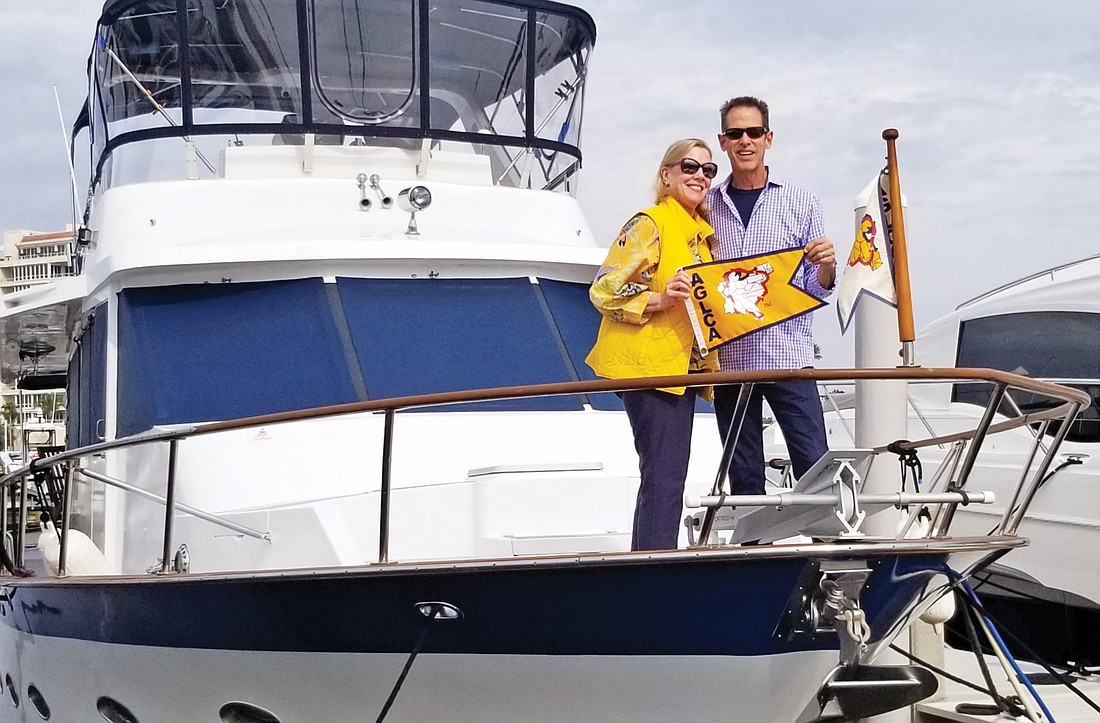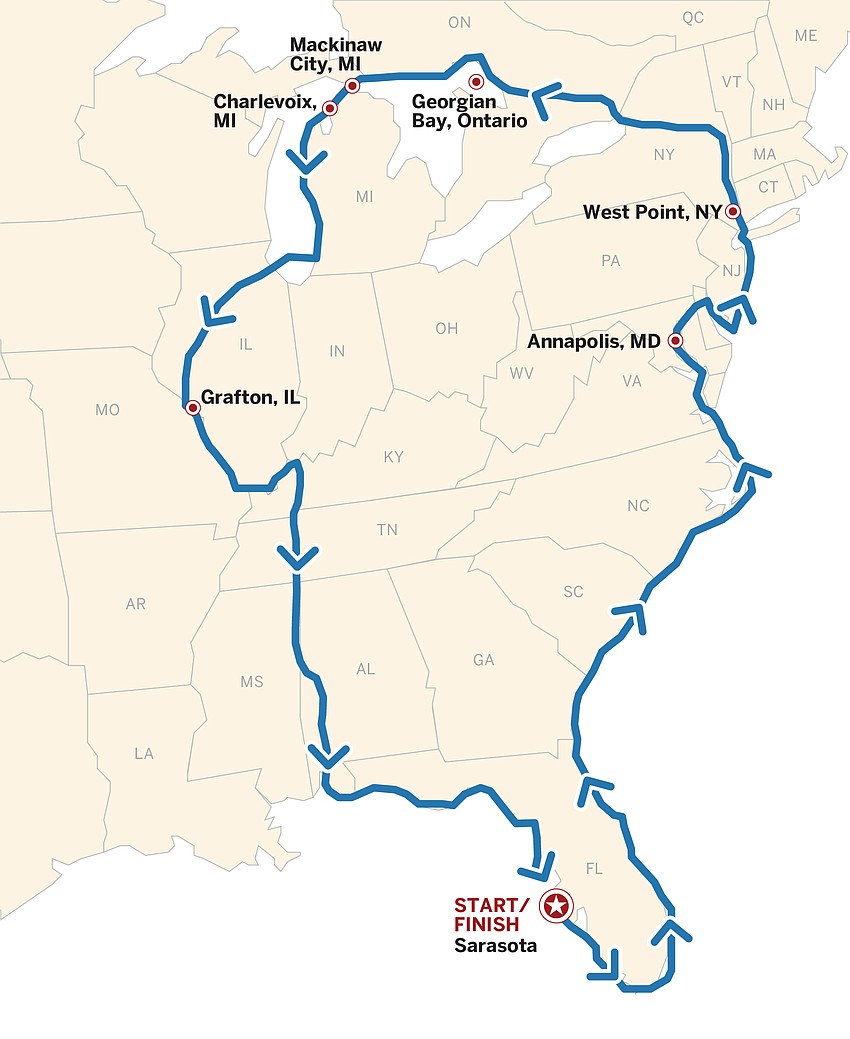- May 1, 2025
-
-
Loading

Loading

It took more than 10 months, but they covered some 6,000 miles by sea, by river, by intracoastal waterway and lake.
Longboat residents Ziggy and Joni von Schweinitz joined a select club of boaters on Dec. 9, 2022, when they completed the Great Loop, a circumnavigation of eastern North American waterways that took them south from Sarasota, around the Florida Keys, then north along the East Coast of the U.S. all the way to New York Harbor before they headed west along the Hudson and into the country’s interior, via rivers, canals and lakes, eventually making their way back into the Gulf of Mexico via the Mississippi, Tennessee and Tombigbee rivers.

It’s hard to place an exact figure on the number of people who complete the circuit each year, but annually approximately 150-200 people report a completed loop to the America's Great Loop Cruisers' Association, said Kim Russo, director of the AGLCA. By doing so, boaters earn a gold flag from the association, signaling the accomplishment to other captains and “loopers.”
Ziggy, 67, and Joni, 74, completed the loop and earned their gold flag on a 50-foot 1989 Defever named Faith.
While some “loopers” purchase a boat specifically for the voyage, the husband and wife pair had been living aboard their vessel part-time for over a decade when they got underway Feb. 1, 2022.
Ziggy essentially single-handed the passage. Joni made no bones about it: she was aboard as a “first-class passenger” and to take in the sights. Captaining the 50-foot boat solo through crowded waterways came naturally to Ziggy. He retired from his career as a Delta pilot two years ago after 44 years in the air, flying, among other craft, Boeing 767s. He’s also been boating for 40 years.
In order to prepare their boat for the voyage, Ziggy outfitted it with fender boards on both sides to protect the boat in the more than 100 locks that he and Joni would travel through. Damage can be done to improperly prepared boats in locks because boats are secured near rough concrete walls while the water level is changed.
The other main preparation was to convert a bunkroom to a storage room for canned goods and other supplies.
“We made a lot of meatloaf,” said Joni.
The challenges began immediately upon departure.
The couple originally planned to cut across Florida via the Okeechobee Waterway from Fort Myers into the Atlantic near Stuart, Florida, but the canal was under maintenance. Instead, the couple had to navigate around the Florida Keys, which meant dealing with traffic around Miami from cruise ships and party boats.
“The hardest part, the most expensive part of the trip was getting out of South Florida. Once we got north of Lake Stuart and Fort Pierce, then things started moderating in terms of marina cost and availability,” said Ziggy.
They made it as far as Annapolis, Maryland, near the end of May without incident, before their generator began to fail. They had planned a week there, but ended up stuck for a month.
“All our air-conditioning systems, our stabilizer system, refrigerator, freezer — all that operates on that generator,” explained Ziggy. “(No electrician) could see me for months.”
Ziggy explained that he eventually convinced an electrician to spend an hour (at double rate) on their boat with a voltmeter, testing various parts. The culprit? A $13 diode, which Ziggy had shipped overnight and installed himself.
After reaching Mackinaw, Michigan, there were issues with fuel contamination, and Ziggy described a harrowing moment on the Tennessee-Tombigbee Waterway when the engines cut out as they were seeking a marina for the night. He had to replace a fuel filter in pitch-black darkness as the current carried them downriver amid barge traffic.
“So I put on the autopilot, which just holds a heading, went tearing downstairs to the engine room … to get the engines going again, then I went tearing back upstairs to the flybridge, and the engines fire back up, I hit the spotlight and we’re still in the middle of the river, and we didn’t hit anything — thank God. That was a little sporting event.”
Their schedule and planning normally kept them off the waterways at night. While there were some long days of 10 and 12 hours underway, Ziggy said, they would generally shove off at 11 a.m. and four to five hours later, “be arriving at our next little town or marina, then go into town, look at what they had to offer.”
“There's some days, I'd say, ‘Well, what day is it? You know, where are we?’” said Joni. “Because you're here one day and then you're leaving, and then you're here for three days and you're leaving.”
Weather was an ever-present concern, but Ziggy and Joni said that was mitigated by forecasting and being flexible.
“The loop was about 50% fun and adventure and 50% work,” said Ziggy. “There's a lot, you know, just from the maintenance of the boat itself, you really have to keep up with all the systems and equipment on the boat.”
There was no shortage of highlights, quaint towns and beautiful views: West Point, New York; Georgian Bay, Ontario. Charlevoix, Michigan; Grafton, Illinois. But the industrial and commercial nature of stretches of the inland rivers was tiresome, the couple said.
But the biggest takeaway for Joni and Ziggy after seeing thousands of miles of the U.S. from the uncommon vantage point of its waterways?
“The biggest takeaway for me was it was like the Sarasota and Longboat Key Appreciation year. We've really got it made here,” said Ziggy.